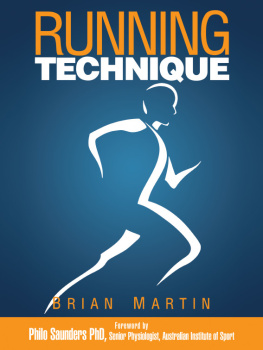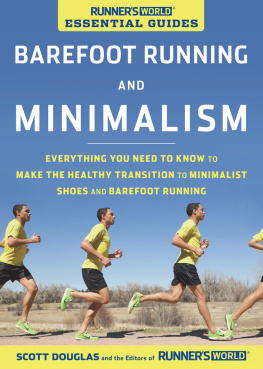ABOUT THE AUTHORS
Ken Bob Saxton is the guru of running barefoot, the worlds leading instructor and proponent of the unshod art. One of the most recognized runners in the world, with his dense beard, long hair, and of course, bare feet, hes been featured in Runners World, the New York Times, hundreds of other periodicals, and the best seller Born to Run. Ken Bob has trained thousands of people across the country in person at his free workshops and through his popular website TheRunningBarefoot.com, where he and thousands of other barefooters worldwide have been sharing their experiences since it (and its precursors) were founded in 1997. He has completed one marathon in shoes and seventy-seven marathons barefoot (as of January 2011), with no plans to do any more of the former. He began his barefoot odyssey when he stopped running in shoes after incurring bad blisters in 1987, and says if he couldnt run barefoot, he probably wouldnt be a runner. Although Ken Bob claims to have no exceptional athletic ability, he has racked up quite respectable PRs of 17:43 in the 5K, 37:02 in the 10K, and 3:18 in the marathon. He has qualified for and run the Boston Marathon several times, survived an astounding marathon-a-month challenge in 2004, and topped that with sixteen marathons in 2006, including four in a fifteen-day periodall barefoot. Most important, he is the type of person who frequently wonders How? as in, How does that work? and Why? as in, Why do we do need shoes for running?
Roy M. Wallack wants to be fit forever. A Southern California writer, editor, and author who specializes in running, cycling, triathlon, fitness training, gear, and adventure travel, he has competed in some of the worlds toughest cycling, running, and multisport events, and has no plans to stop. A longtime fitness-gear columnist and feature writer for the Los Angeles Times, he is the former editor of Triathlete, Bicycle Guide, and California Bicyclist magazines, and a contributor to a variety of magazines, including Outside, Mens Journal, Runners World, Muscle & Fitness, Bicycling, Mountain Bike, Playboy, Competitor, Consumers Digest, and others. Convinced that staying fit is one of the keys to happiness and that we all can be lifelong athletes, Roy has authored and coauthored several books that lay out plans for high-level, long-term fitness: Be a Better Runner (2011), Run for Life: The Breakthrough Plan for Fast Times, Fewer Injuries, and Spectacular Lifelong Fitness (2009), Bike for Life: How to Ride to 100 (2005), and The Traveling Cyclist: 20 Worldwide Tours of Discovery (1991), which describes his thousands of miles of bike trips around the world, including the first one into the Soviet Union, in 1988. A former collegiate wrestler, Roy has done hundreds of running, cycling, and triathlon races and has participated in some of the worlds toughest endurance events, such as the Badwater Ultramarathon; the weeklong Eco-Challenge and Primal Quest adventure races; the 750-mile (1,200 km) Paris-Brest-Paris randone; and epic multiday mountain-bike stage races, including TransAlp and TransRockies Challenges, La Ruta de los Conquistadores, BC Bike Race, and the Breck Epic. He was inducted into the 24 Hours of Adrenalin Solo Hall of Fame in 2008 and finished second in the World Fitness Championship in 2004.

CHAPTER 1
BORN TO RUN BAREFOOT
THE LIFE AND TIMES OF BAREFOOT KEN BOB

How an unusually sensitive boy who couldnt stand tobacco smoke, coffee, polyester disco shirts, or shoes listened to his body and discovered running barefoot rule #1: Bend your knees!
WE HAVE SENSES TO MAKE THE EVERYDAY THINGS WE DO LESS DANGEROUS AND LESS PAINFUL. TO IGNORE THESE SENSES IS TO LIVEAND RUNSENSELESSLY!
KEN BOB-ISM #5
Some say that genetics is destiny. For me, looking back on how running barefoot became such an essential part of who I am, and why I think it can make life better for millions of people, its more like sensitivity is destiny.
When my neighborhood friends in rural northwest lower Michigan were smoking and drinking in their teens, I didnt. When my parents fired up a pot of coffee every morning, I left the kitchen. This was not due to any conservative morality or health obsession. I was just extremely sensitive, and I tried to avoid discomfort and pain.
Cigarette smoke gave me headaches. One whiff of cigar smoke and I felt like puking. Beer just didnt taste good. The scent of coffee made me nauseous; a coffee-flavored milk drink once made me vomit and have diarrhea. Perfume and cologne gave me headaches. The Lost in Spaceinspired synthetic pullover sweaters of the 1960s made me itch like crazy. My disco-fever polyester shirts of the 70s made my skin feel like it was crawling with bugs.
For a long time, I thought something was wrong with me. I couldnt roller skate for long in my cool skate clothes because they made me uncomfortable. I squirmed in class adjusting my clothing. Id stay home from school not because I was sick, but because I felt like I was going to be; it must have worked because I almost never got truly sick. My shoes blistered and chafed, so I took them off every chance I got.
Running barefoot around the local fields, forests, and swamps, I noticed that my first footfalls seemed to rattle my brain, so I somehow began landing more gently (although I didnt realize how I did thisby bending my knees deeplyuntil years later). It was a classic feedback loop: if its uncomfortable or painful, dont ignore it or tough it out; either drop it or figure out a more comfortable way to do it. My body complained about a lot of minor, run-of-the-mill stuff that didnt seem to bother anyone else. But fortunately, I listened to my bodysomething I advise everyone to do. It forced me to figure out easier ways to get things done, not by cheating or shortcutting but by being more efficient.
Although my hypersensitivity was a hassle as a kid, making it hard to fit in and learn how to socialize, I later began to see it as a gift, an early warning system, a canary in the coal mine. A similar sensitivity motivated my oldest brother to convince our parents to stop smoking.
I would be the only teen not drinking at a party, and I became shy, almost a loner. But as I began to accept myself for who I was, I began to like not fitting in with the crowd; as it turns out, the crowd didnt have any special wisdom. I liked the fact that I was repelled by things that probably arent great for anybodysuch as nicotine, toxic synthetics (the polyester disco shirts, and possibly disco music, too), overly processed foods (I often suffered severe constipation-induced cramps until I figured that one out), and running with stiff legs, which pounds feet into the ground without much shock absorption. It was all about my body giving me a gift of true wisdom. All I needed to do was listen and respond appropriately!
Two decades ago, my odd supersensitivity finally led me to ditch my shoes for good and dedicate my spare time to telling people about the benefits of running, walking, and being barefoot. As I will try to show you, if there is one overriding philosophy that captures the essence of barefooting, it is listening to your body. This can virtually eliminate most common running injuries, improve performance, restore and lengthen your running career, and just feel great. Your body always tells you the truthif you can develop enough sensitivity over the years to understand it.











